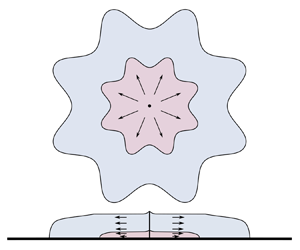Published online by Cambridge University Press: 11 April 2022

We examine the stability of radially spreading, gravity-driven thin films of power-law fluids, lubricated from below by another power-law viscous fluid. Such flows are susceptible to a viscous fingering instability, also known as a non-porous viscous fingering instability, when a less viscous fluid intrudes beneath a more viscous fluid. In contrast to the Saffman–Taylor instability, such instabilities originate from a jump in hydrostatic pressure gradient across the intrusion front, associated with gradients in the upper surface. These are stabilised by buoyancy forces associated with the lower layer near its nose, and all instabilities are suppressed above a critical density difference. We find that shear-thinning flows are more prone to instability than Newtonian and shear-thickening flows. Lower consistency ratios are sufficient for the onset of instability of shear-thinning flows, and the stabilising influences of buoyancy forces are suppressed. As such, higher density differences are required to suppress the instability completely.